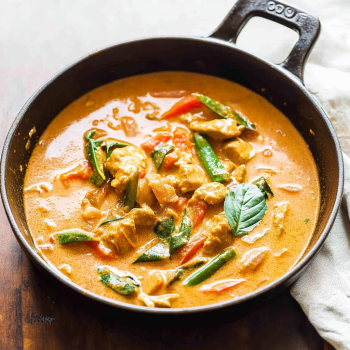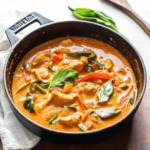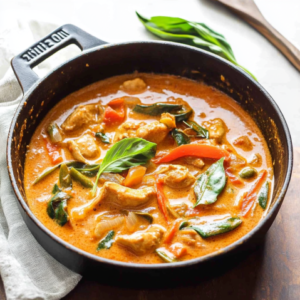Advertisement
Panang Curry Recipe
What is Panang Curry?
Panang curry is a rich and creamy Thai dish that delights the senses. It features a unique blend of flavors, combining sweet, salty, and spicy elements. The base of this curry is made from coconut milk, which gives it a smooth texture and a hint of sweetness. The star of the show is the Panang curry paste, a fragrant mix of herbs and spices, including lemongrass, galangal, and kaffir lime leaves. This curry is often made with chicken, but it can also be prepared with beef, pork, or even tofu for a vegetarian option. The result is a comforting dish that is perfect for any occasion.
The Origins of Panang Curry
Panang curry hails from Thailand, specifically from the central region. It is named after the island of Penang, which is located in Malaysia. The dish reflects the cultural exchange between Thailand and Malaysia, showcasing the use of local ingredients and cooking techniques. Traditionally, Panang curry is thicker than other Thai curries, thanks to the generous use of coconut milk and the way it is prepared. Over the years, it has gained popularity worldwide, becoming a favorite in Thai restaurants and homes alike. Its rich flavors and creamy texture make it a beloved dish for many.
Ingredients for Panang Curry Recipe
Essential Ingredients
To create a delicious Panang curry, you’ll need a few essential ingredients. These components work together to build the rich flavors that make this dish so special. Here’s what you’ll need:
- Vegetable oil: This is used for sautéing the onions and other ingredients.
- Onion: Thinly sliced, it adds sweetness and depth to the curry.
- Garlic: Minced garlic brings a wonderful aroma and flavor.
- Ginger: Grated ginger adds a warm, spicy note.
- Panang curry paste: The heart of the dish, this paste is packed with spices and herbs.
- Coconut milk: This creamy base gives the curry its signature texture and sweetness.
- Chicken breast: Thinly sliced, it cooks quickly and absorbs the flavors well.
- Red bell pepper: Sliced for color and crunch.
- Green beans: Trimmed and added for freshness and a slight crunch.
- Fish sauce: This salty ingredient enhances the overall flavor.
- Brown sugar: A touch of sweetness balances the spices.
- Lime juice: Fresh lime juice adds brightness and acidity.
- Fresh basil leaves: These are used for garnish, adding a fragrant touch.
- Cooked jasmine rice: This is served alongside the curry, making it a complete meal.
Optional Ingredients for Customization
While the essential ingredients create a fantastic Panang curry, you can customize it to suit your taste. Here are some optional ingredients you might consider:
Advertisement
- Thai bird chilies: For those who love heat, adding these chilies will spice things up.
- Tofu: A great substitute for chicken, perfect for a vegetarian or vegan version.
- Vegetable broth: Use this instead of fish sauce for a vegetarian-friendly option.
- Other vegetables: Feel free to add carrots, zucchini, or snap peas for more variety.
- Peanuts: Chopped peanuts can add a delightful crunch and nutty flavor.
Step-by-Step Preparation of Panang Curry Recipe
Step 1: Preparing the Ingredients
Before you start cooking, it’s important to prepare all your ingredients. This makes the cooking process smoother and more enjoyable. Begin by slicing the onion, red bell pepper, and chicken breast. Mince the garlic and grate the ginger. Make sure to trim the green beans as well. Having everything ready will help you move quickly through the recipe.
Step 2: Making the Panang Curry Paste
If you’re using store-bought Panang curry paste, you can skip this step. However, if you want to make your own, combine fresh herbs and spices. Blend together ingredients like lemongrass, galangal, kaffir lime leaves, and dried chilies. This homemade paste will give your curry a fresh and vibrant flavor. Remember, the quality of your paste can greatly affect the taste of your dish.
Step 3: Cooking the Protein
Heat the vegetable oil in a large skillet over medium heat. Once hot, add the sliced onion. Sauté until it becomes translucent, which should take about 3-4 minutes. Next, stir in the minced garlic and grated ginger. Cook for an additional minute until fragrant. Then, add the thinly sliced chicken breast. Cook until the chicken is no longer pink, which will take about 5-7 minutes. This step is crucial as it ensures your protein is cooked perfectly.
Step 4: Combining Ingredients
After the chicken is cooked, it’s time to add the Panang curry paste. Stir well to combine it with the onion and chicken mixture. This allows the flavors to meld together beautifully. Then, pour in the coconut milk, stirring until the curry paste is fully dissolved. This creamy base is what makes Panang curry so special.
Step 5: Simmering the Curry
Bring the mixture to a gentle simmer. This is where the magic happens! Add the sliced red bell pepper and green beans. Cook for another 3-4 minutes until the vegetables are tender-crisp. This step ensures that the veggies retain their vibrant color and crunch, adding texture to your dish.
Step 6: Final Touches
Once the vegetables are cooked, it’s time to season your curry. Stir in the fish sauce, brown sugar, and lime juice. Taste and adjust the seasoning as needed. Finally, remove the skillet from heat and garnish with fresh basil leaves. Serve your delicious Panang curry hot over cooked jasmine rice. Enjoy the delightful flavors and aromas!
Variations of Panang Curry Recipe

Vegetarian and Vegan Options
If you’re looking for a vegetarian or vegan twist on the classic Panang curry, you’re in luck! You can easily substitute the chicken with tofu or tempeh. Both options absorb flavors well and provide a satisfying texture. For a vegan version, replace fish sauce with soy sauce or a vegan fish sauce alternative. Additionally, using vegetable broth instead of chicken broth will keep the dish plant-based. You can also add more vegetables like carrots, zucchini, or mushrooms to enhance the dish’s nutrition and flavor. This way, you can enjoy a delicious Panang curry that aligns with your dietary preferences.
Different Protein Choices
While chicken is a popular choice for Panang curry, you can experiment with various proteins. Beef and pork are excellent alternatives, offering a different flavor profile. Thinly sliced beef cooks quickly and pairs well with the rich curry sauce. If you prefer seafood, shrimp or fish can also be delightful options. Just be sure to adjust the cooking time accordingly, as seafood cooks faster than chicken. Each protein brings its unique taste, allowing you to customize your Panang curry to your liking.
Spice Level Adjustments
For those who enjoy a little heat, adjusting the spice level of your Panang curry is easy. You can add sliced Thai bird chilies when cooking the onions for an extra kick. Alternatively, if you prefer a milder flavor, simply reduce the amount of Panang curry paste you use. Remember, you can always add more spice later, but it’s hard to take it away once it’s in! Experimenting with the spice level allows you to create a dish that suits your taste buds perfectly.
Cooking Note for Panang Curry Recipe
Tips for Achieving the Perfect Flavor
Creating a delicious Panang curry is all about balancing flavors and using quality ingredients. Here are some tips to help you achieve the perfect flavor:
- Use Fresh Ingredients: Fresh herbs and vegetables make a big difference. Whenever possible, opt for fresh garlic, ginger, and basil. They enhance the overall taste of your curry.
- Quality Curry Paste: The flavor of your Panang curry largely depends on the quality of the curry paste. If you can, try to find a high-quality brand or make your own. This will elevate your dish significantly.
- Adjust Seasoning Gradually: When adding fish sauce, brown sugar, and lime juice, do so gradually. Taste as you go to find the right balance of salty, sweet, and sour. This ensures that your curry is perfectly seasoned.
- Don’t Overcook the Vegetables: To keep your vegetables vibrant and crunchy, avoid overcooking them. They should be tender-crisp when added to the curry. This adds texture and color to your dish.
- Let It Rest: After cooking, let your curry sit for a few minutes before serving. This allows the flavors to meld together, resulting in a more harmonious dish.
- Garnish Generously: Fresh basil leaves not only add a pop of color but also enhance the aroma. Don’t skimp on the garnish; it makes your dish look and taste even better.
By following these tips, you’ll be well on your way to making a flavorful and satisfying Panang curry that everyone will love. Enjoy the cooking process and the delightful aromas that fill your kitchen!
Serving Suggestions for Panang Curry Recipe
Best Accompaniments
When it comes to serving your delicious Panang curry, choosing the right accompaniments can elevate the meal. Here are some fantastic options to consider:
- Jasmine Rice: This fragrant rice is a classic pairing with Panang curry. Its fluffy texture soaks up the rich sauce beautifully, making each bite delightful.
- Sticky Rice: For a different texture, try serving sticky rice. It’s fun to eat and complements the creamy curry perfectly.
- Fresh Salad: A light, fresh salad with cucumber, carrots, and a tangy dressing can balance the richness of the curry. It adds a refreshing crunch to your meal.
- Spring Rolls: Crispy spring rolls filled with vegetables or shrimp make a great appetizer. They add a nice contrast to the warm curry.
- Thai Pickles: These tangy pickles can cut through the richness of the curry, providing a burst of flavor that enhances the overall dining experience.
Presentation Ideas
Presentation plays a key role in making your Panang curry visually appealing. Here are some creative ideas to make your dish stand out:
- Colorful Bowls: Serve your curry in vibrant bowls that contrast with the creamy sauce. This adds a pop of color to your table.
- Garnish Generously: Use fresh basil leaves and lime wedges as garnishes. They not only look beautiful but also add freshness to the dish.
- Layered Serving: For a more elegant presentation, layer the jasmine rice and curry in a bowl. This creates a stunning visual effect.
- Chili Oil Drizzle: A light drizzle of chili oil on top of the curry can add a touch of sophistication and a hint of spice.
- Serve with a Side of Lime: Placing lime wedges on the side allows guests to add a splash of acidity to their curry, enhancing the flavors.
By considering these serving suggestions and presentation ideas, you can create a delightful dining experience that showcases your delicious Panang curry. Enjoy sharing this flavorful dish with family and friends!
Tips for Making the Best Panang Curry Recipe
Common Mistakes to Avoid
Making a delicious Panang curry is a rewarding experience, but there are some common mistakes to watch out for. Here are a few tips to help you avoid pitfalls:
- Skipping the Sautéing: Don’t rush the sautéing process. Cooking the onions, garlic, and ginger until fragrant is crucial. This step builds the foundation of flavor for your curry.
- Using Low-Quality Curry Paste: The quality of your Panang curry paste can make or break the dish. Always opt for a high-quality brand or make your own for the best results.
- Overcooking the Chicken: Be careful not to overcook the chicken. It should be tender and juicy. Cooking it just until no longer pink is key to a great texture.
- Neglecting to Taste: Always taste your curry as you cook. Adjust the seasoning gradually to find the perfect balance of flavors. This ensures your dish is well-seasoned.
- Forgetting the Garnish: Fresh basil leaves are not just for decoration; they add a burst of flavor. Don’t skip this important finishing touch!
By avoiding these common mistakes, you’ll be on your way to creating a fantastic Panang curry that impresses everyone at the table.
Storage and Reheating Tips
If you have leftovers, storing and reheating your Panang curry properly is essential to maintain its delicious flavor. Here are some helpful tips:
- Cool Before Storing: Allow your curry to cool to room temperature before transferring it to an airtight container. This helps prevent condensation, which can make the curry watery.
- Refrigerate: Store your Panang curry in the refrigerator for up to 3-4 days. Make sure it’s sealed tightly to keep it fresh.
- Freezing: If you want to keep it longer, you can freeze the curry. It can last for up to 2-3 months in the freezer. Just be sure to use a freezer-safe container.
- Reheating: When reheating, do so gently on the stove over low heat. Stir occasionally to ensure even heating. You can add a splash of coconut milk or water if it seems too thick.
- Microwave Option: If you’re in a hurry, you can use the microwave. Heat in short intervals, stirring in between, until warmed through.
Following these storage and reheating tips will help you enjoy your Panang curry even after the first serving. It’s just as delicious the next day!
Breakdown of Time for Panang Curry Recipe
Prep Time
Preparing your ingredients is a crucial step in making a delicious Panang curry. The prep time typically takes about 15-20 minutes. During this time, you will slice the onion, red bell pepper, and chicken breast. Additionally, you’ll mince the garlic, grate the ginger, and trim the green beans. Having everything ready before you start cooking will make the process smoother and more enjoyable.
Cooking Time
The cooking time for your Panang curry is approximately 20-25 minutes. This includes sautéing the onions, garlic, and ginger, cooking the chicken, and simmering the curry with the vegetables. Each step is essential to build the rich flavors that make this dish so special. Remember, cooking times may vary slightly depending on your stove and the thickness of your chicken slices.
Total Time
In total, you can expect to spend around 35-45 minutes from start to finish when making Panang curry. This includes both prep and cooking times. It’s a relatively quick dish to prepare, making it perfect for a weeknight dinner or a special occasion. With just a little time and effort, you can enjoy a flavorful and satisfying meal that everyone will love!
Nutritional Information for Panang Curry Recipe
Calories and Macronutrients
Understanding the nutritional content of your Panang curry can help you make informed choices about your meals. Each serving of this delightful dish contains approximately 450 calories. Here’s a breakdown of the macronutrients:
- Calories: 450
- Net Carbs: 10g
- Protein: 30g
- Fat: 30g
This balance of macronutrients makes Panang curry a satisfying meal. The protein from chicken helps build and repair tissues, while healthy fats from coconut milk provide energy and support cell function. The low net carbs make it a great option for those watching their carbohydrate intake.
Health Benefits of Ingredients
Each ingredient in your Panang curry contributes unique health benefits. Here’s a closer look at some of the key components:
- Coconut Milk: Rich in healthy fats, coconut milk can help improve heart health and provide a quick source of energy. It also contains lauric acid, which has antimicrobial properties.
- Chicken Breast: A lean source of protein, chicken breast supports muscle growth and repair. It’s also low in fat, making it a healthy choice for many diets.
- Red Bell Pepper: Packed with vitamins A and C, red bell peppers boost your immune system and promote healthy skin. They also contain antioxidants that help fight inflammation.
- Green Beans: These crunchy veggies are high in fiber, which aids digestion and helps maintain a healthy weight. They also provide essential vitamins and minerals.
- Garlic: Known for its health benefits, garlic can help lower blood pressure and cholesterol levels. It also has anti-inflammatory and antioxidant properties.
- Ginger: This spice is great for digestion and can help reduce nausea. It also has anti-inflammatory effects and may help lower blood sugar levels.
By enjoying Panang curry, you not only indulge in a delicious meal but also nourish your body with wholesome ingredients. This dish is a perfect example of how flavorful food can also be good for you!
FAQs about Panang Curry Recipe
What is the difference between Panang curry and other Thai curries?
Panang curry stands out from other Thai curries due to its unique flavor profile and thicker consistency. Unlike green or red curries, which are often more broth-like, Panang curry is creamier thanks to the generous use of coconut milk. Additionally, Panang curry paste contains a special blend of spices, including kaffir lime leaves and peanuts, giving it a distinct taste. This combination of flavors makes Panang curry rich and aromatic, setting it apart from its counterparts.
Advertisement
Can I make Panang curry ahead of time?
Absolutely! Making Panang curry ahead of time is a great idea. In fact, the flavors often deepen and improve after sitting for a while. You can prepare the curry and store it in an airtight container in the refrigerator for up to 3-4 days. Just reheat it gently on the stove before serving. If you plan to freeze it, ensure it cools completely before transferring it to a freezer-safe container. It can last for up to 2-3 months in the freezer. Just remember to thaw it in the refrigerator overnight before reheating.
What can I substitute for coconut milk in Panang curry?
If you need a substitute for coconut milk, there are a few options you can try. Almond milk or soy milk can work in a pinch, but they won’t provide the same creamy texture or flavor. For a closer match, consider using cashew cream or a mixture of half-and-half with a bit of coconut extract. If you’re looking for a dairy-free option, you can also use vegetable broth combined with a little nut butter for creaminess. Just keep in mind that these alternatives may alter the final taste of your Panang curry.
How spicy is Panang curry compared to other curries?
Panang curry is generally milder than some other Thai curries, like green curry, which can pack a punch. However, the spice level can vary based on the amount of Panang curry paste you use and any additional chilies you add. If you enjoy a bit of heat, you can easily increase the spice by adding Thai bird chilies or more curry paste. Conversely, if you prefer a milder flavor, simply reduce the amount of paste. This flexibility allows you to customize the spice level to suit your taste!
Conclusion on Panang Curry Recipe
Recap of Key Points
In summary, the Panang curry recipe is a delightful dish that combines rich flavors and creamy textures. With essential ingredients like coconut milk, Panang curry paste, and fresh vegetables, you can create a meal that is both satisfying and nutritious. The step-by-step preparation makes it easy to follow, whether you’re a seasoned cook or a beginner. Remember to customize your curry with different proteins or spice levels to suit your taste. The health benefits of the ingredients, such as chicken, garlic, and ginger, add to the appeal of this dish, making it a wholesome choice for any occasion.
Encouragement to Try the Recipe
Now that you have all the information you need, it’s time to roll up your sleeves and try making this delicious Panang curry! Whether you’re cooking for yourself, family, or friends, this dish is sure to impress. The vibrant colors and aromatic flavors will create a memorable dining experience. Don’t hesitate to experiment with the ingredients and make it your own. Enjoy the process, and most importantly, savor every bite of your homemade Panang curry. Happy cooking!
Print
Panang Curry Recipe: A Delicious Thai Delight!
- Total Time: 25 minutes
- Yield: 4 servings
Description
Rich, creamy, and irresistibly fragrant, this Thai Chicken Panang Curry is a perfect balance of savory, sweet, and spicy flavors. Made with tender chicken, aromatic curry paste, coconut milk, and a hint of lime—this curry comes together quickly for a delicious weeknight meal!
Ingredients
- 1 lb (450g) boneless, skinless chicken breast or thighs, sliced thin
- 2 tablespoons Panang curry paste
- 1 can (14 oz) coconut milk
- 1 tablespoon peanut butter (optional, for extra creaminess)
- 1 tablespoon fish sauce
- 1 tablespoon brown sugar
- 1 tablespoon vegetable oil
- 1 red bell pepper, sliced
- 1 small onion, thinly sliced
- 1–2 kaffir lime leaves (optional)
- 1 tablespoon lime juice
- Fresh basil or Thai basil, for garnish
- Salt to taste
- Cooked jasmine rice, for serving
Instructions
-
Heat vegetable oil in a large skillet or wok over medium heat.
-
Add sliced onion and bell pepper, stir-fry for 2-3 minutes until slightly tender.
-
Stir in Panang curry paste and cook for 1 minute to release the aroma.
-
Add chicken slices and stir-fry until chicken is browned and almost cooked through.
-
Pour in coconut milk, stir to combine, and bring to a simmer.
-
Add peanut butter, fish sauce, brown sugar, and kaffir lime leaves (if using). Simmer for 5-7 minutes until chicken is fully cooked and sauce thickens.
-
Stir in lime juice, adjust seasoning with salt or extra fish sauce if desired.
-
Garnish with fresh basil and serve hot over jasmine rice.
Notes
- Protein Options: Swap chicken for tofu, shrimp, or beef as preferred.
- Panang Curry Paste: You can adjust the amount based on your heat preference.
- Storage: Leftovers can be stored in an airtight container in the fridge for up to 3 days. Flavors deepen over time!
- Prep Time: 10 minutes
- Cook Time: 15 minutes
- Category: Main Course
- Method: Stove Top
- Cuisine: Thai





